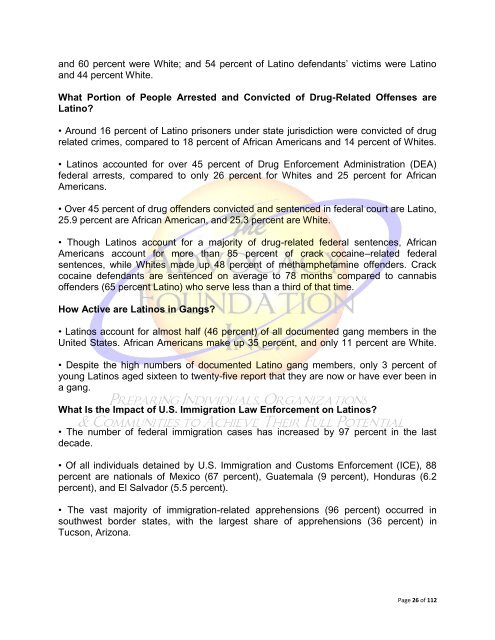Latino and Hispanic Youth in the Juvenile Justice System
Latino and Hispanic Youth in the Juvenile Justice System
Latino and Hispanic Youth in the Juvenile Justice System
Create successful ePaper yourself
Turn your PDF publications into a flip-book with our unique Google optimized e-Paper software.
<strong>and</strong> 60 percent were White; <strong>and</strong> 54 percent of <strong>Lat<strong>in</strong>o</strong> defendants’ victims were <strong>Lat<strong>in</strong>o</strong><br />
<strong>and</strong> 44 percent White.<br />
What Portion of People Arrested <strong>and</strong> Convicted of Drug-Related Offenses are<br />
<strong>Lat<strong>in</strong>o</strong>?<br />
• Around 16 percent of <strong>Lat<strong>in</strong>o</strong> prisoners under state jurisdiction were convicted of drug<br />
related crimes, compared to 18 percent of African Americans <strong>and</strong> 14 percent of Whites.<br />
• <strong>Lat<strong>in</strong>o</strong>s accounted for over 45 percent of Drug Enforcement Adm<strong>in</strong>istration (DEA)<br />
federal arrests, compared to only 26 percent for Whites <strong>and</strong> 25 percent for African<br />
Americans.<br />
• Over 45 percent of drug offenders convicted <strong>and</strong> sentenced <strong>in</strong> federal court are <strong>Lat<strong>in</strong>o</strong>,<br />
25.9 percent are African American, <strong>and</strong> 25.3 percent are White.<br />
• Though <strong>Lat<strong>in</strong>o</strong>s account for a majority of drug-related federal sentences, African<br />
Americans account for more than 85 percent of crack coca<strong>in</strong>e–related federal<br />
sentences, while Whites made up 48 percent of methamphetam<strong>in</strong>e offenders. Crack<br />
coca<strong>in</strong>e defendants are sentenced on average to 78 months compared to cannabis<br />
offenders (65 percent <strong>Lat<strong>in</strong>o</strong>) who serve less than a third of that time.<br />
How Active are <strong>Lat<strong>in</strong>o</strong>s <strong>in</strong> Gangs?<br />
• <strong>Lat<strong>in</strong>o</strong>s account for almost half (46 percent) of all documented gang members <strong>in</strong> <strong>the</strong><br />
United States. African Americans make up 35 percent, <strong>and</strong> only 11 percent are White.<br />
• Despite <strong>the</strong> high numbers of documented <strong>Lat<strong>in</strong>o</strong> gang members, only 3 percent of<br />
young <strong>Lat<strong>in</strong>o</strong>s aged sixteen to twenty-five report that <strong>the</strong>y are now or have ever been <strong>in</strong><br />
a gang.<br />
What Is <strong>the</strong> Impact of U.S. Immigration Law Enforcement on <strong>Lat<strong>in</strong>o</strong>s?<br />
• The number of federal immigration cases has <strong>in</strong>creased by 97 percent <strong>in</strong> <strong>the</strong> last<br />
decade.<br />
• Of all <strong>in</strong>dividuals deta<strong>in</strong>ed by U.S. Immigration <strong>and</strong> Customs Enforcement (ICE), 88<br />
percent are nationals of Mexico (67 percent), Guatemala (9 percent), Honduras (6.2<br />
percent), <strong>and</strong> El Salvador (5.5 percent).<br />
• The vast majority of immigration-related apprehensions (96 percent) occurred <strong>in</strong><br />
southwest border states, with <strong>the</strong> largest share of apprehensions (36 percent) <strong>in</strong><br />
Tucson, Arizona.<br />
Page 26 of 112

















